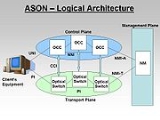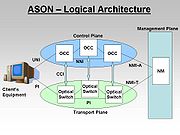
ASON
Encyclopedia
ASON is a concept for the evolution of transport networks which allows for dynamic policy-driven control of an optical or SDH
network based on signaling between a user and components of the network. Its aim is to automate the resource and connection management within the network. The IETF defines ASON as an alternative/supplement to NMS based connection management.
( These requirements are not restricted to optical networks and can be applied to any transport network (including SDH Networks). )
 The logical architecture of an ASON can be divided into 3 planes:
The logical architecture of an ASON can be divided into 3 planes:
The Transport Plane contains a number of switches (optical or otherwise) responsible for transporting user data via connections. These switches are connected to each other via PI (Physical Interface).
The Control Plane is responsible for the actual resource and connection management within an ASN network. It consists of a series of OCC (Optical Connection Controllers), interconnected via NNIs (Network to Network Interfaces). These OCCs have the following functions:
The Management Plane is responsible for managing the Control plane. Its responsibilities include Configuration Management of the Control Plane Resources, Routing Areas, Transport resource in Control Plane and Policy. It also provides Fault Management, Performance Management, Accounting and Security Management functions. The Management Plane contains the Network Management Entity which is connected to an OCC in Control Plane via the NMI-A ( Network Management Interface for ASON Control Plane) and to one of the switches via NMI-T ( Network Management Interface for the Transport Network).
The traffic from user connected to an ASON network contains data for both Transport and Control Plane. The user is connected to Transport plane via a PI (Physical Interface), while it communicates with the Control plane via a UNI ( User Network Interface).
has worked on the requirements and architecture of ASON based on the requirements on its members, it is explicitly aiming to avoid the development of new protocols, when existing ones will work fine. The IETF, on the other hand , has been tasked with the development of new protocols in response to general industry requirement. Therefore, while ITU already include the PNNI protocol for signaling in the Control plane, IETF has been developing GMPLS as a second option protocol to be used in the Control Plane for signalling. As a product of IETF, GMPLS (Generalized MPLS
) uses IP
to communicate between different components in the Control Plane.
SDH
SDH may refer to:* Synchronous Digital Hierarchy, in telecommunications* Secure Digital Host Controller, in computing* Saradhna, a railway station in India* The Shubnikov-De Haas effect, also see Fermi surface...
network based on signaling between a user and components of the network. Its aim is to automate the resource and connection management within the network. The IETF defines ASON as an alternative/supplement to NMS based connection management.
The Need for ASON
In an optical network without ASON, whenever a user requires more bandwidth, there is a request for a new connection from the user to the service provider. The service provider must then manually plan and configure the route in the network. This is not only time consuming, but also wastes bandwidth if the user sparingly uses the connection. Bandwidth is increasingly becoming a precious resource and expectations from future optical networks are that they should be able to efficiently handle resources as quickly as possible. ASON fulfills some of the requirements of optical networks such as:- Fast and automatic end-to-end provisioning
- Fast and efficient re-routing
- Support of different clients, but optimized for IPInternet ProtocolThe Internet Protocol is the principal communications protocol used for relaying datagrams across an internetwork using the Internet Protocol Suite...
- Dynamic set up of connections
- Support of Optical Virtual Private Networks (OVPNs)
- Support of different levels of quality of service
( These requirements are not restricted to optical networks and can be applied to any transport network (including SDH Networks). )
Logical Architecture of An ASON

- Transport Plane
- Control Plane
- Management Plane
The Transport Plane contains a number of switches (optical or otherwise) responsible for transporting user data via connections. These switches are connected to each other via PI (Physical Interface).
The Control Plane is responsible for the actual resource and connection management within an ASN network. It consists of a series of OCC (Optical Connection Controllers), interconnected via NNIs (Network to Network Interfaces). These OCCs have the following functions:
- Network topologyNetwork topologyNetwork topology is the layout pattern of interconnections of the various elements of a computer or biological network....
discovery (resource discovery) - Signaling, routingRoutingRouting is the process of selecting paths in a network along which to send network traffic. Routing is performed for many kinds of networks, including the telephone network , electronic data networks , and transportation networks...
, address assignment - Connection set-up/tear-down
- Connection protection/restoration
- Traffic engineeringTraffic engineeringTraffic engineering can mean:* traffic engineering , a branch of civil engineering* teletraffic engineering, a field of statistical techniques used in telecommunications...
- Wavelength assignment
The Management Plane is responsible for managing the Control plane. Its responsibilities include Configuration Management of the Control Plane Resources, Routing Areas, Transport resource in Control Plane and Policy. It also provides Fault Management, Performance Management, Accounting and Security Management functions. The Management Plane contains the Network Management Entity which is connected to an OCC in Control Plane via the NMI-A ( Network Management Interface for ASON Control Plane) and to one of the switches via NMI-T ( Network Management Interface for the Transport Network).
The traffic from user connected to an ASON network contains data for both Transport and Control Plane. The user is connected to Transport plane via a PI (Physical Interface), while it communicates with the Control plane via a UNI ( User Network Interface).
The Role of IETF
While ITUItu
Itu is an old and historic municipality in the state of São Paulo in Brazil. The population in 2009 was 157,384 and the area is 641.68 km². The elevation is 583 m. This place name comes from the Tupi language, meaning big waterfall. Itu is linked with the highway numbered the SP-75 and are flowed...
has worked on the requirements and architecture of ASON based on the requirements on its members, it is explicitly aiming to avoid the development of new protocols, when existing ones will work fine. The IETF, on the other hand , has been tasked with the development of new protocols in response to general industry requirement. Therefore, while ITU already include the PNNI protocol for signaling in the Control plane, IETF has been developing GMPLS as a second option protocol to be used in the Control Plane for signalling. As a product of IETF, GMPLS (Generalized MPLS
Multiprotocol Label Switching
Multiprotocol Label Switching is a mechanism in high-performance telecommunications networks that directs data from one network node to the next based on short path labels rather than long network addresses, avoiding complex lookups in a routing table. The labels identify virtual links between...
) uses IP
Internet Protocol
The Internet Protocol is the principal communications protocol used for relaying datagrams across an internetwork using the Internet Protocol Suite...
to communicate between different components in the Control Plane.
ITU-T documentation for ASON standardization
The following is a list and description of architecture and requirements as published by ITU-T- G.8080/Y.1304, Architecture for the automatically switched optical network (ASON)
- G.807/Y.1302, Requirements for automatic switched transport networks (ASTN) Call and Connection Management
- G.7713/Y.1704, Distributed call and connection management (DCM)
- G.7713.1/Y.1704.1, DCM signalling mechanism using PNNI/Q.2931
- G.7713.2/Y.1704.2, DCM signalling mechanism using GMPLS RSVP-TE
- G.7713.3/Y.1704.3, DCM signalling mechanism using GMPLS CR-LDP Discovery and Link Management
- G.7714/Y.1705, Generalized automatic discovery techniques
- G.7715/Y.1706, Architecture and requirements of routing for automatic switched transport network
- G.7716/Y.1707, Architecture and requirements of link resource management for automatically switched transport networks
- G.7717/Y.1708, ASTN connection admission control. Other Related Recommendations
- G.872, Architecture of optical transport networks
- G.709/Y.1331, Interface for the optical transport network (OTN)
- G.959.1, Optical transport network physical layer interfaces
- G.874, Management aspects of the optical transport network element
- G.874.1, Optical transport network (OTN) protocolneutral management information model for the network element view.
- G.875, Optical transport network (OTN) management information model for the network element view
- G.7041/Y.1303, Generic framing procedure (GFP)
- G.7042/Y.1305, Link capacity adjustment scheme (LCAS) for virtual concatenated signals
- G.65x, series on optical fibre cables and test methods
- G.693, Optical interfaces for intra-office systems
- G.7710/Y.1701, Common equipment management function requirements
- G.7712/Y.1703, Architecture and specification of data communication network.
- G.806, Characteristics of transport equipment . Description methodology and generic functionality.

